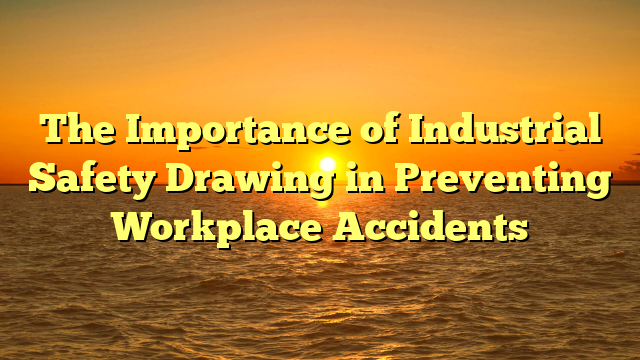Industrial Safety Drawing: Ensuring Safe Work Environments
👷♂️👷♀️Safety is an essential aspect of any industrial workplace. However, the use of heavy machinery, electrical equipment, and hazardous materials can lead to accidents, injuries, and even fatalities. To ensure the safety of workers, industrial safety drawings are crucial. These drawings depict the safe use and handling of equipment, the proper storage of hazardous materials, and emergency procedures. In this blog post, we will explore the importance of industrial safety drawing and its related keywords such as safety standards, safety compliance, safety training, safety regulations, and safety procedures.
What is Industrial Safety Drawing?
Industrial safety drawing is a visual representation of safety procedures and protocols in a workplace. It is a set of drawings, diagrams, and schematics that illustrate safety measures to prevent accidents and injuries. These drawings are created by professionals who are knowledgeable about safety standards and regulations. They are typically used in industries such as manufacturing, construction, and engineering.
The Importance of Industrial Safety Drawing
Industrial safety drawing is critical for ensuring a safe work environment. These drawings provide workers with clear instructions on how to operate machinery and equipment safely. They also depict the proper storage and handling of hazardous materials, emergency procedures, and evacuation routes. Industrial safety drawings are essential to preventing workplace accidents and injuries.
Listicle: Safety Standards and Compliance
1. Adherence to safety standards and compliance is essential for maintaining a safe work environment.
2. Industrial safety drawings must comply with safety standards set by regulatory authorities.
3. Non-compliance with safety standards can result in fines, penalties, and legal action.
4. Regular safety inspections and audits can help ensure compliance with safety standards.
Tutorial: Creating Industrial Safety Drawings
Creating industrial safety drawings requires expertise in safety standards and regulations. Here are the steps to create an industrial safety drawing:
1. Identify the safety hazards and risks in the workplace.
2. Determine the safety standards and regulations that apply to the industry.
3. Outline the procedures and protocols for safe operation of equipment and machinery.
4. Create clear and concise drawings and diagrams that illustrate the safety procedures.
5. Ensure that the drawings comply with safety standards and regulations.
Tips: Safety Training and Regulations
1. Safety training should be mandatory for all workers in the workplace.
2. Workers should be trained on the proper use of machinery and equipment.
3. Regular safety drills and exercises can help ensure that workers are prepared for emergencies.
4. Employers should comply with safety regulations and provide workers with a safe work environment.
Question and Answer of Industrial Safety Drawing
Q: What are the benefits of industrial safety drawing in the workplace?
A: Industrial safety drawing helps prevent accidents, injuries, and fatalities in the workplace. It also ensures compliance with safety regulations and standards.
Q: How can employers ensure that workers follow the safety procedures depicted in the industrial safety drawing?
A: Employers should provide regular safety training and conduct safety drills and exercises. They should also enforce safety protocols and hold workers accountable for non-compliance.
Q: What are some common safety hazards in industrial workplaces?
A: Common safety hazards in industrial workplaces include falls, electrocution, burns, toxic exposure, and machinery accidents.
Q: What are the consequences of non-compliance with safety standards and regulations?
A: Non-compliance with safety standards and regulations can result in fines, penalties, and legal action. It can also lead to workplace accidents, injuries, and fatalities.
Conclusion of Industrial Safety Drawing
Industrial safety drawing is crucial for ensuring a safe work environment. It helps prevent accidents, injuries, and fatalities by providing workers with clear instructions on how to operate machinery and equipment safely. Employers should comply with safety regulations and provide regular safety training to workers. By prioritizing safety, industrial workplaces can create a culture of safety that benefits workers and the organization as a whole.
Recommendations:
- Vehicle Safety Inspection Checklist When do i need a vehicle inspection checklist template. Missouris motor vehicle safety inspection program requires each vehicle for professional or personal use to go through a series of checks…
- Construction Site Safety Inspection Checklist The standards referred to are south carolinas occupational safety and health standards for the construction industry as adopted from 29 cfr code of federal regulations part. Some construction companies will…
- Safety Poster Vector Download safety posters and safety clipart to hang in your work areas or use in your safety presentations. Safety safety safety icon safety icon safety equipment safety equipment safety. Safety…
- Safety Slogans For September Using a new iphone app a team of social psychology experts has analysed every meaningless aphorism and every condescending platitude ever displayed in the workplace to come up with a…
- Safety Plan Worksheet For Adults It is important that the safety plan worksheet is completed with the therapist and patient working together. 1 feeling safe being safe ety in an gency. Safety Plan Worksheet Therapist…
- Construction Safety Inspection Checklist Template It can be completed in a single inspection or over a series of shorter inspections. Includes checks for first aid facilities fire prevention emergencies site security ppe and more. Construction…
- Safety Topics Electrical If a worker has been retaliated against for using their rights they must file a complaint with osha as soon as possible but no later. Delivery couriers and messengers biological…
- Safety Inspection Report Example Page 1 of 3. Formal inspections can take different forms and you and your representatives will need to agree the best methods for your workplace. Safety Report Templates 16 Pdf…
- Workplace Safety Inspection Checklist Template Use our professionally designed workplace safety inspection checklist template that you can download instantly. After you have used it a couple of times you may wish to modify it so…
- Safety Training Logo We deliver professional world class training to operators of business and regional aircraft with a compelling mix of resources designed to satisfy ongoing training needs. The photos above are from…
- Safety First Clip Art We summarised more than 50 safety first clip art for your safety campaigns. Download it.
- Safety Inspection Report For Construction Site Once corrected record corrective action and date next to item. Yes no na date corrected. 22 Sample Construction Report Templates Word Docs Pages Free Be fitted with suitable safety hoops…
- Safety Inspection Report Safety reports aims to improve the safety of their employees by creating high quality and easy to use safety apps for any need. The intent of the site inspection is…
- Safety Quotes For Workplace Display them around your workplace or add them to internal newsletters. Find the best catchy competition winning heath and safety slogans and safety messages for your workplace 2020 quotable quote.…
- Health And Safety Slogans For The Workplace As described in our earlier post on safety slogans safety posters can be installed throughout the organization to educate employees to work safely. At work at home let safety be…
- Health Safety Inspection Workplace Inspection… For example you can focus on the most common tasks your workers perform or on. 177 free health and safety checklists. Pshsa Sample Workplace Inspection Checklist Name of health and…
- Electrical Safety Poster Our products are appreciated for various quality for example high glue quality climate. Work safety posters. Acrylic Sheet Electrical Safety Poster Shape Square Rectangle Rs This powerpoint has been produced…
- Workplace Safety Slogans Safety First Quotes See more ideas about safety slogans workplace safety and safety. 167 catchy and funny safety slogans for workplaces 2020 find the best catchy safety slogans for your workplace stop press.…
- Funny Safety Quotes For Work Im sure youll remember at least a few of these safety quotes. Im not going to lie. Funny Safety Quotes Safety Toolbox Talks Meeting Topics If you get killed at…
- Electrical Safety Posters Hd Find and save ideas about safety posters on pinterest. Safety images photos unsafe pictures and funny fails. Acrylic Sheet Electrical Safety Poster Shape Square Rectangle Rs Posted by admin on…
- Safety Quotes For The Workplace Funny In this post we are going to share with you a list of 57 funny safety slogans. Researchers reveal the top 10 most effective safety slogans ever click here. Funny…
- Safety Quotes For The Workplace Display them around your workplace or add them to internal newsletters. Apr 25 2019 explore sotorioss board safety quotes for workplace on pinterest. Safety Quotes For The Workplace Safety In…
- Electrical Safety Topics Free electrical safety checklists. Get started with this free collection of iauditor electrical safety checklists you can use on your worksite. 10 Rules For Workplace Electrical Safety Electrical Electrical More…
- Vehicle Safety Inspection Form I cant find it anywhere on the website or through the app to download and p. This form must be filled up by the driver which will serve as a…
- Safety Inspection Report Format Safety inspection report forms are forms that are used by professionals to report on the kind of safety violations if there are any of certain establishments by conducting a thorough…
- Vehicle Safety Inspection Checklist Form Know how to operate the vehicle and use and related equipment or attachments safely. Brad gates created date. Vehicle Safety Inspection Checklist Form Vehicle Vehicle Any item not passing inspection…
- Safety Slogansquotes For Workplace Researchers reveal the top 10 most effective safety slogans ever click here. Here is a list of the most catchy safety slogans for the workplace. 201 Catchy Safety Slogans For…
- Safety Slogan Posters Images Following are the safety slogans and taglines. What others are saying industrial safety training servicescourses in india. Foam Sheet Safety Slogan Poster Rs 280 8 Piece Protector Safety slogans be…
- Industrial Safety Posters Free Downloads Injury facts 2014 edition. Great quality best price. Workplace Safety Posters Downloadable And Printable Alsco Post bright safety slogan signs and encourage safety in your facility. Industrial safety posters free…
- Electrical Safety Precautions In Laboratory Most incidents are a. Electrical safety in the laboratory. Safety Precautions In Electric Lab English Precautions can be employed when working in the laboratory to avoid electric shock and electrical…
Advertisement
Scroll to Continue With Content




